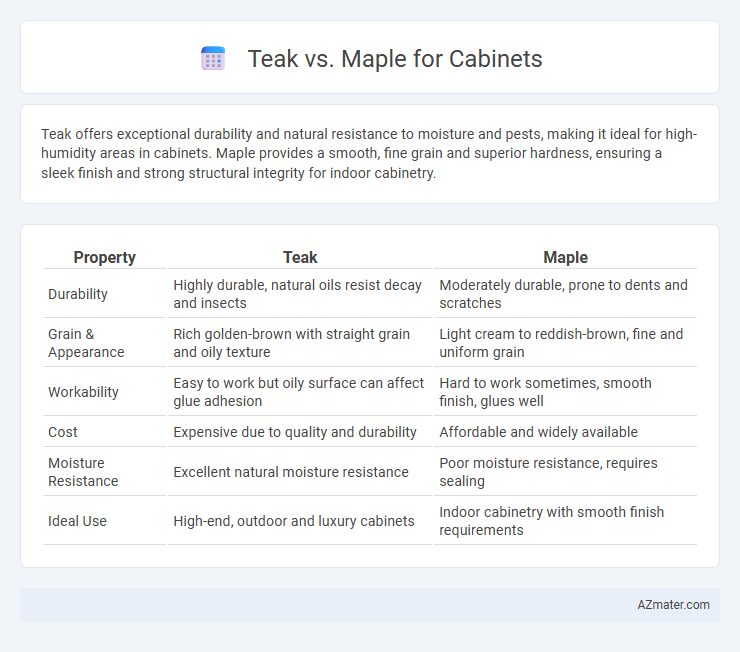Teak offers exceptional durability and natural resistance to moisture and pests, making it ideal for high-humidity areas in cabinets. Maple provides a smooth, fine grain and superior hardness, ensuring a sleek finish and strong structural integrity for indoor cabinetry.
Table of Comparison
| Property | Teak | Maple |
|---|---|---|
| Durability | Highly durable, natural oils resist decay and insects | Moderately durable, prone to dents and scratches |
| Grain & Appearance | Rich golden-brown with straight grain and oily texture | Light cream to reddish-brown, fine and uniform grain |
| Workability | Easy to work but oily surface can affect glue adhesion | Hard to work sometimes, smooth finish, glues well |
| Cost | Expensive due to quality and durability | Affordable and widely available |
| Moisture Resistance | Excellent natural moisture resistance | Poor moisture resistance, requires sealing |
| Ideal Use | High-end, outdoor and luxury cabinets | Indoor cabinetry with smooth finish requirements |
Introduction to Teak and Maple Cabinets
Teak cabinets are renowned for their exceptional durability and natural resistance to moisture, making them ideal for kitchens and bathrooms where humidity is a concern. Maple cabinets offer a smooth, consistent grain and light color that can easily adapt to various stains and finishes, providing versatile design options. Both hardwoods deliver strength and longevity, but teak's oil content and maple's fine texture cater to different aesthetic and functional preferences in cabinetry.
Origin and Availability of Teak and Maple
Teak originates primarily from Southeast Asia, especially countries like Myanmar, India, and Thailand, known for its durability and natural resistance to moisture, making it ideal for cabinet construction in humid environments. Maple, native to North America, is widely available and valued for its fine, uniform grain and light color, offering a versatile choice for cabinetry with easy access due to its abundance. Availability of teak is more limited and often higher in cost compared to maple, which is more common and sustainably harvested in many regions, influencing cabinet production decisions based on budget and aesthetic preferences.
Appearance and Grain Patterns
Teak cabinets showcase rich golden-brown hues with natural oils that enhance durability and a smooth texture, while maple offers a lighter, creamy color with subtle reddish or golden undertones that brighten spaces. The grain pattern of teak is typically straight with occasional wavy lines, providing a warm and exotic appearance, whereas maple features a fine, consistent grain that can range from straight to slightly curly, lending a clean and modern aesthetic. Both woods provide unique visual appeal, with teak emphasizing warmth and depth and maple highlighting brightness and simplicity in kitchen cabinetry.
Durability and Strength Comparison
Teak offers exceptional durability and natural resistance to moisture, insects, and decay, making it a top choice for long-lasting cabinetry in humid environments. Maple features a dense, fine grain structure that provides excellent strength and resistance to wear, ideal for cabinets subjected to heavy use. While teak excels in outdoor and high-moisture conditions, maple delivers superior hardness and abrasion resistance for indoor cabinetry.
Resistance to Moisture and Pests
Teak is highly resistant to moisture and pests due to its natural oils and dense grain, making it ideal for cabinets in humid environments. Maple, while durable and dense, lacks the inherent oils that protect against moisture and insect damage, requiring proper sealing to enhance its resistance. Choosing teak for cabinets in moisture-prone areas offers superior longevity and pest resistance compared to maple.
Maintenance Requirements
Teak cabinets require less frequent maintenance due to their natural oil content, which resists moisture, insects, and decay, making them ideal for high-humidity areas. Maple cabinets, while durable, need regular sealing and cleaning to prevent staining and wear from humidity fluctuations. Both woods benefit from periodic polishing, but teak's inherent resistance reduces the need for heavy upkeep compared to maple.
Environmental Impact and Sustainability
Teak cabinets are highly durable and resistant to pests, but their slow growth and high demand contribute to deforestation concerns, making certified sustainably harvested teak essential. Maple, a fast-growing hardwood commonly sourced from North American forests, offers a more renewable option with less environmental strain and better opportunities for sustainable forestry management. Choosing FSC-certified maple or teak guarantees responsible harvesting practices that minimize ecological impact and support long-term forest health.
Cost Differences: Teak vs Maple
Teak cabinets typically cost more than maple due to teak's natural durability, resistance to moisture, and rich grain quality, making it a premium hardwood choice. Maple is more affordable and widely available, offering a smooth surface ideal for paint or stain finishes without compromising strength. Price differences average 20-40% higher for teak, influenced by its slower growth rate and import costs compared to domestic maple.
Best Applications for Each Wood
Teak wood is ideal for cabinets in humid or outdoor environments due to its natural oil content and resistance to moisture, making it perfect for kitchens and bathrooms where durability and water resistance are essential. Maple wood, known for its fine, uniform grain and hardness, excels in indoor cabinetry that requires a smooth finish and the ability to withstand heavy use, such as in pantries and dining room storage. Choosing teak is best for long-lasting, weather-resistant applications, while maple suits elegant interior designs demanding precision and strength.
Final Verdict: Choosing the Right Wood for Cabinets
Teak offers exceptional durability and natural resistance to moisture and pests, making it ideal for cabinets in humid environments. Maple provides a smooth, consistent grain with excellent hardness and affordability, perfect for sleek, modern cabinetry. Selecting the right wood depends on balancing teak's longevity and moisture resistance with maple's cost-effectiveness and classic appearance.

Infographic: Teak vs Maple for Cabinet
 azmater.com
azmater.com